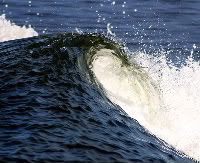Ocean Wave Energy Project

I’ve seen many dozens of ideas in this arena, but the bottom line is that I’m not a huge fan. I like to reduce things to their most basic simplicities. The kinetic energy in ocean waves came from the kinetic energy in the wind, which in turn came from the radiant energy from the sun. The closer we can get to the source (the sun), the more efficient and ultimately cost-effective this whole clean energy enterprise is going to be. When we have PV at $0.56 per Watt, I would think the ocean wave people would be having trouble getting investors on board.
As always, I invite comment; if I’m off base here, perhaps someone can correct me.

I disagree Craig. The element that gathers this energy in water (waves)is a natural device. It is huge, well proven, and best yet it is free. To even begin to capture a micro micro amount of this energy would cost billions of dollars trying to collect it in the form of sunlight. This is so obvious I do not understand how you could have come to the conclusion you have.
Are you telling me that their cost per Watt competes (or could possibly compete) with solar and wind? I find that incredibly hard to believe.
Craig,
Tim is correct here – probably. The question is the longevity of ocean-based energy projects, and that’s uncertain.
But the levelized cost of energy (LCOE) is extremely high for solar. The panel costs have reduced due to pressure from China, with First Solar the only possible survivor of that trade war… but panels are not the only cost for solar energy. You’ve got the install costs (qualified labor working on a rooftop); the real-estate costs, the wiring costs, the inverter (which probably won’t last more than ~15 years), the tracking systems… and you have degradation – both in the panels and in the wiring/junctions.
All told, you’re lucky to get an installed system for less than ~$3.50/W before government subsidies are considered.
Most places don’t get better insolation than what could allow for ~20% capacity factor. Assuming a 0.8%/year degradation, and a 7% discount rate for the capital costs for 15 years before the first major maintenance cost kicks in (inverter replacement); the unsubsidised LCOE for solar power is $195/MWh.
That’s pretty easy for wave energy to beat, with an installed cost of ~$5-7/W, but a capacity factor of 90+%… it all depends on the longevity of the system.
Wind in a reasonable wind zone is still BY FAR the lowest cost energy to consider… That’s still the low-hanging fruit.
Yes, the capacity factor is a huge advantage for wave. But it strikes me that these bulky devices are going to be terribly expensive — even in theory. And, as you pointed out, what happens in practice is anyone’s guess. The problems that we encounter when we insert a device into a marine environment are not to be underestimated.